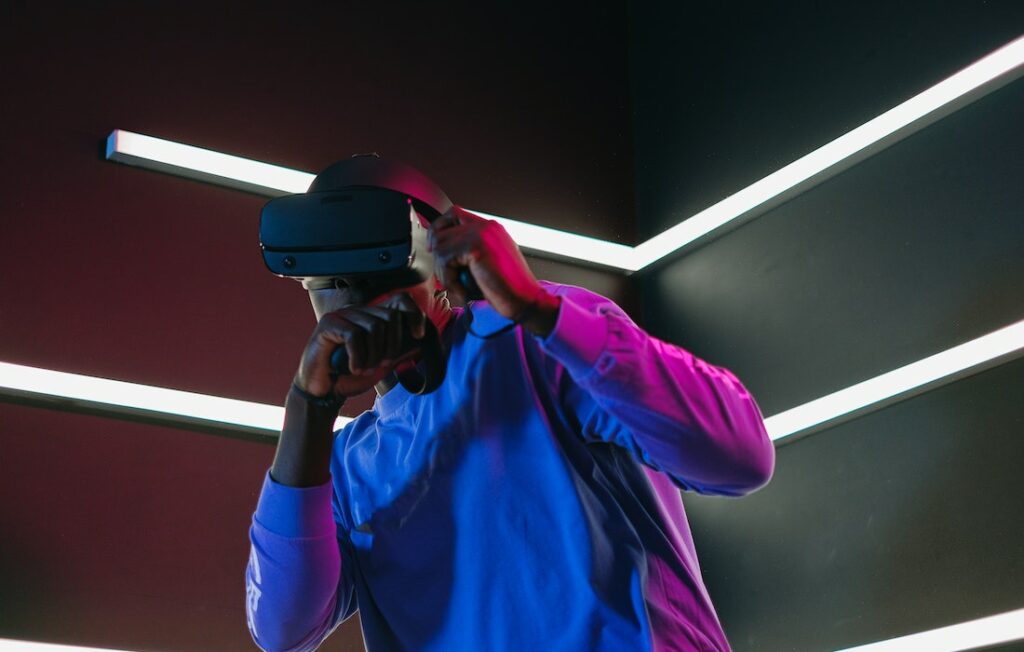I. Introduction
Consumer technology is rapidly changing as the digital revolution continues to expand and evolve. These advancements are unprecedentedly transforming people’s lives, from voice-controlled smart devices to self-driving cars. With each breakthrough in tech, users can do more with devices and quickly access information worldwide. It’s no surprise that many experts believe this is only the beginning and that many more game-changing technologies are yet to come.
This article explores the future of consumer tech, highlighting key emerging trends and their potential impact. If you’re an aspiring entrepreneur, tech enthusiast, or just curious about the future of consumer technology, this is the article for you!
II. Artificial Intelligence and Machine Learning
As more businesses seek to leverage the power of artificial intelligence (AI) and machine learning, these technologies are increasingly becoming integrated into consumer tech products. AI-powered devices can now provide users with personalized recommendations, anticipate their needs, and even automate certain processes, such as driving.

Smart assistants like Amazon’s Alexa or Apple’s Siri have become commonplace in homes worldwide. Furthermore, AI and machine learning can now power personalized recommendation systems. For example, Netflix uses a sophisticated algorithm to recommend movies and TV shows tailored to viewers’ preferences.
Autonomous vehicles are also leveraging AI-powered technologies. Self-driving cars, for example, use sensors and cameras combined with computer vision algorithms to detect their surroundings and navigate roads safely. According to a report from Statista, the global autonomous car market is expected to reach USD 62 billion by 2026.
III. Internet of Things (IoT) and Connected Devices
With almost every device and appliance becoming connected to the Internet, the Internet of Things (IoT) ecosystem is quickly expanding. Wearable devices such as smartwatches enable users to track their physical activity and monitor their health. Smart homes allow homeowners to control lights, thermostats, and security systems through a single app. Connected appliances can provide helpful notifications when something needs to be changed or repaired.
The impact of the IoT on daily life is undeniable. From reducing energy consumption to providing real-time data analysis, connected devices are enabling consumers and businesses to do more with less. In addition, IoT-enabled devices can provide unprecedented levels of convenience and security for homeowners.
The possibilities for innovative IoT devices are endless. For instance, Bosch’s Home Connect oven can be connected to a smartphone or tablet, allowing users to control their cooking from anywhere. In addition, Samsung’s Family Hub refrigerator provides a central platform for grocery shopping, meal planning, streaming music and videos, and more.
IV. Augmented Reality (AR) and Virtual Reality (VR)

Augmented reality (AR) and virtual reality (VR) are two of the most talked-about technologies in the consumer tech space. While AR overlays digital elements onto a user’s real environment, VR completely immerses users into a simulated world.
AR is gaining traction in gaming, entertainment, and e-commerce. For example, Snapchat has created a platform for brands to deliver AR experiences directly to users’ phones. Meanwhile, Niantic’s Pokemon Go was one of the most popular mobile games of 2016 and relied heavily on augmented reality.
On the other hand, virtual reality has been touted as the next big thing in entertainment. Popular applications include gaming, immersive experiences, and virtual travel. Companies such as Oculus and HTC have developed headsets specifically designed for VR content.
According to Statista, the AR/VR market is expected to reach USD 250 billion by 2026. This demonstrates an increasing demand for user-friendly AR/VR products and services across multiple industries.
V. 5G Connectivity and Edge Computing
Of course, the future of consumer tech is not complete without 5G connectivity. 5G networks are capable of providing faster speeds, lower latency, and increased capacity compared to previous generations. This makes them ideal for powering high-bandwidth applications such as streaming services and virtual reality.
In addition, 5G will dramatically reduce the time it takes for data to travel between devices, allowing for more responsive applications and services. This could lead to faster downloads, smoother gaming experiences, and improved 3D graphics.
Edge computing is another technology that will be powered by 5G. It involves storing data closer to users to reduce latency and provide a better user experience. For example, Google is working on edge networks that could deliver real-time AR/VR content without requiring users to download large files.
A recent report from Juniper Research estimated that 5G networks will drive USD 625 billion in consumer tech spending by 2027. This demonstrates the potential for 5G technologies to revolutionize how consumers interact with their devices and services.
VI. Biometric Authentication and Security
Security concerns have always been a priority for consumer tech companies. To address this, many are turning to biometric authentication and security features. Biometrics involves using physical or behavioral characteristics to identify individuals, such as fingerprints, facial recognition, and voice recognition.
One example of biometric authentication is Apple’s Face ID feature on its iPhones. This enables users to unlock their devices with their faces rather than entering a numerical passcode. Similarly, many laptops now have fingerprint sensors for added security and convenience.
Industry experts say biometric authentication provides better security than traditional passwords or PINs. The global biometrics market is estimated to reach USD 55 billion by 2025, demonstrating strong consumer demand for such features.
VII. Sustainable and Eco-Friendly Tech
Of course, the future of consumer tech needs to be sustainable and eco-friendly. As consumers become more aware of the environmental impact of their purchases, many companies are responding with products that prioritize sustainability.
One example is energy-efficient devices, such as laptops and televisions with power-saving modes. Such devices reduce electricity consumption and can help save money in the long run. In addition, many products now use recyclable materials such as aluminum and plastic.
According to a recent survey by Accenture, more than half of consumers globally believe companies should be more concerned with sustainability when developing new products or services. Furthermore, the survey found that 81% of consumers would pay more for sustainable products.
VIII. Quantum Computing and Edge AI

Some of the most cutting-edge technologies in consumer tech are quantum computing and edge AI. Quantum computers rely on principles from quantum physics to process information at speeds far beyond what is possible with traditional computers. This could enable faster processing, improved encryption, and sophisticated application optimization algorithms.
Meanwhile, edge AI involves running AI models locally on devices rather than on the cloud. This could enable faster response times, improved privacy, and lower latency for applications such as facial recognition or voice assistants. In addition, edge AI could be used to power autonomous vehicles by enabling real-time decision-making.
Recent reports suggest that quantum computers will become viable within the next 5 to 10 years. Similarly, edge AI is expected to be widely adopted soon. As these technologies progress, they will continue revolutionizing the consumer tech space and spark new innovations.
IX. Voice and Gesture Control Interfaces
With the emergence of voice-powered devices such as smart speakers, it’s no surprise that voice and gesture control interfaces are quickly becoming popular in consumer tech. Voice commands allow users to conveniently access information or control their devices with just a few words. Similarly, gesture controls can enable users to interact with their devices without pressing any buttons.
Voice assistants such as Apple’s Siri, Amazon’s Alexa, and Google Assistant are now commonplace in households worldwide. Such devices can be used to play music, answer questions, or even order groceries. Smartphones and gaming consoles such as Microsoft’s Xbox also feature voice and gesture controls for various tasks.
In addition, voice-enabled services are becoming more accessible for users with disabilities. For example, Apple’s VoiceOver feature can navigate through an iPhone’s interface via voice commands. Similarly, Microsoft’s Xbox Adaptive Controller enables gamers to play without using a traditional gamepad.
X. Personalized and Adaptive Technologies
Finally, personalized and adaptive technologies are becoming increasingly popular as more businesses realize the potential of tailoring services to individual users. Personalized devices such as fitness trackers or smartwatches can monitor user data to provide customized advice and recommendations.
In addition, adaptive learning platforms use machine learning algorithms to adjust their content for each user’s needs and preferences. For example, the Khan Academy uses an AI-powered system to determine which areas students need help with and provide personalized lessons accordingly.
A recent survey found that almost 70% of companies believe personalization is key to improving customer experiences. Furthermore, 76% of respondents said they plan on investing in personalized technologies over the next three years. This demonstrates the growing demand for personalized and adaptive technologies in the consumer tech space.
XI. Conclusion
As technology advances, so do the possibilities for innovative consumer products and services. From AI-powered devices to biometric authentication, a variety of cutting-edge technologies have already changed how people interact with their devices and services. The transformative potential of 5G, quantum computing, edge AI, and more will continue to push the boundaries of what is possible in consumer tech.
Moreover, as consumers become more aware of sustainability issues, companies are responding with eco-friendly products that prioritize both convenience and sustainability. With so many exciting developments happening in the consumer tech space, it’s clear that innovation shows no signs of slowing down.
As the consumer tech industry continues to evolve, it will be interesting to see how these technologies shape our lives in the years to come. With the right combination of innovation and sustainability, consumer tech companies can create products that are accessible and beneficial to everyone. It’s an exciting time for any technology enthusiast!

